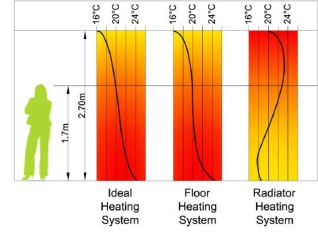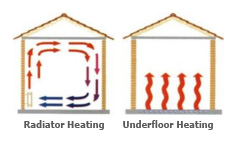
Ground Source Heat
Benefits
Process
→ Assessment of Project Design
→ Reducing the Heating Requirement
→ Delivering the Warmth
→ Providing the Heat
→ Your Final Saving
Frequently Asked Questions
Case Histories
Delivering the Warmth
Having established the client's requirements, the following is known:• Each room temperature
• Floor surfaces in each room
• Other forms of heating and their locations
• Any other requirements or constraints
Wherever possible we would recommend underfloor heating, but low surface temperature radiators are an alternative as are reheat batteries in the incoming air flow.
Underfloor heating provides an almost ideal heating profile in a room – warm heat cooler face and coldest above our heads. Exactly the opposite from the profile achieved by conventional radiators.
 This is achieved by slowly releasing heat and creating minimal convection currents, which never reach the ceiling. A further benefit is that dust from the floor is not lifted and spread around the room – a great benefit for asthma sufferers.
This is achieved by slowly releasing heat and creating minimal convection currents, which never reach the ceiling. A further benefit is that dust from the floor is not lifted and spread around the room – a great benefit for asthma sufferers.
Stone or ceramic tiles offer the optimal solution for a surface over underfloor heating, but they must be laid correctly using the correct adhesives. Tiles then become an integral part of the heat source, boosting the efficiency of the heating system.
 Wood floors or carpets can also be installed. Their insulation properties mean that, either the underfloor heating pipes must be more densely laid or the temperature of the water in the underfloor heating must be higher. The choice of the wood or the carpet is critical, so we ensure that the client receives the correct advice.
Wood floors or carpets can also be installed. Their insulation properties mean that, either the underfloor heating pipes must be more densely laid or the temperature of the water in the underfloor heating must be higher. The choice of the wood or the carpet is critical, so we ensure that the client receives the correct advice.
Low Surface Temperature Radiators
In certain applications the installation of radiators using water at about 45°C may be advantageous, particularly in care homes or hospitals, but such radiators take up a significant amount of wall space.
Domestic Hot Water
Generally, in the home hot water is used at a temperature of about 42°C after mixing with cold water. For commercial laundering the temperature can be as high as 80°C. The quantities of hot water required depend upon the appliances installed and whether showers or baths are the preferred method of bathing. If high temperatures are required an auxiliary method of heating will be specified. Next Stage





